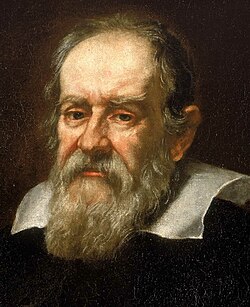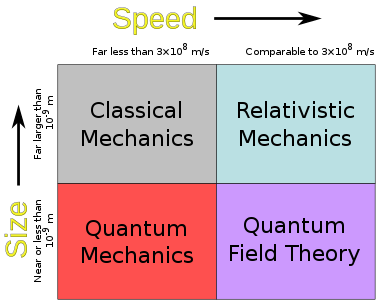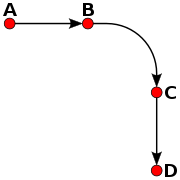Inertia is the resistance, of any physical object, to any change in its velocity. This includes changes to the object's speed, or direction of motion.
An aspect of this property is the tendency of objects to keep moving in a straight line at a constant speed, when no forces are upon them — and this aspect in particular is also called inertia.
The principle of inertia is one of the fundamental principles in classical physics that are still used today to describe the motion of objects and how they are affected by the applied forces on them.
Inertia comes from the Latin word, iners, meaning idle, sluggish. Inertia is one of the primary manifestations of mass, which is a quantitative property of physical systems. Isaac Newton defined inertia as his first law in his Philosophiæ Naturalis Principia Mathematica, which states:
On the surface of the Earth, inertia is often masked by the effects of friction and air resistance, both of which tend to decrease the speed of moving objects (commonly to the point of rest), and gravity. This misled the philosopher Aristotle to believe that objects would move only as long as force was applied to them:
An aspect of this property is the tendency of objects to keep moving in a straight line at a constant speed, when no forces are upon them — and this aspect in particular is also called inertia.
The principle of inertia is one of the fundamental principles in classical physics that are still used today to describe the motion of objects and how they are affected by the applied forces on them.
Inertia comes from the Latin word, iners, meaning idle, sluggish. Inertia is one of the primary manifestations of mass, which is a quantitative property of physical systems. Isaac Newton defined inertia as his first law in his Philosophiæ Naturalis Principia Mathematica, which states:
The vis insita, or innate force of matter, is a power of resisting by which every body, as much as in it lies, endeavours to preserve its present state, whether it be of rest or of moving uniformly forward in a straight line.In common usage, the term "inertia" may refer to an object's "amount of resistance to change in velocity" (which is quantified by its mass), or sometimes to its momentum, depending on the context. The term "inertia" is more properly understood as shorthand for "the principle of inertia" as described by Newton in his First Law of Motion: an object not subject to any net external force moves at a constant velocity. Thus, an object will continue moving at its current velocity until some force causes its speed or direction to change.
On the surface of the Earth, inertia is often masked by the effects of friction and air resistance, both of which tend to decrease the speed of moving objects (commonly to the point of rest), and gravity. This misled the philosopher Aristotle to believe that objects would move only as long as force was applied to them:
...it [body] stops when the force which is pushing the travelling object has no longer power to push it along...
History and development of the concept
Early understanding of motion
Prior to the Renaissance, the most generally accepted theory of motion in Western philosophy was based on Aristotle who around about 335 BC to 322 BC said that, in the absence of an external motive power, all objects (on Earth) would come to rest and that moving objects only continue to move so long as there is a power inducing them to do so. Aristotle explained the continued motion of projectiles, which are separated from their projector, by the action of the surrounding medium, which continues to move the projectile in some way. Aristotle concluded that such violent motion in a void was impossible.Despite its general acceptance, Aristotle's concept of motion was disputed on several occasions by notable philosophers over nearly two millennia. For example, Lucretius (following, presumably, Epicurus) stated that the "default state" of matter was motion, not stasis. In the 6th century, John Philoponus criticized the inconsistency between Aristotle's discussion of projectiles, where the medium keeps projectiles going, and his discussion of the void, where the medium would hinder a body's motion. Philoponus proposed that motion was not maintained by the action of a surrounding medium, but by some property imparted to the object when it was set in motion. Although this was not the modern concept of inertia, for there was still the need for a power to keep a body in motion, it proved a fundamental step in that direction. This view was strongly opposed by Averroes and by many scholastic philosophers who supported Aristotle. However, this view did not go unchallenged in the Islamic world, where Philoponus did have several supporters who further developed his ideas.
Theory of impetus
In the 14th century, Jean Buridan rejected the notion that a motion-generating property, which he named impetus, dissipated spontaneously. Buridan's position was that a moving object would be arrested by the resistance of the air and the weight of the body which would oppose its impetus. Buridan also maintained that impetus increased with speed; thus, his initial idea of impetus was similar in many ways to the modern concept of momentum. Despite the obvious similarities to more modern ideas of inertia, Buridan saw his theory as only a modification to Aristotle's basic philosophy, maintaining many other peripatetic views, including the belief that there was still a fundamental difference between an object in motion and an object at rest. Buridan also believed that impetus could be not only linear, but also circular in nature, causing objects (such as celestial bodies) to move in a circle.Buridan's thought was followed up by his pupil Albert of Saxony (1316–1390) and the Oxford Calculators, who performed various experiments that further undermined the classical, Aristotelian view. Their work in turn was elaborated by Nicole Oresme who pioneered the practice of demonstrating laws of motion in the form of graphs.
Shortly before Galileo's theory of inertia, Giambattista Benedetti modified the growing theory of impetus to involve linear motion alone:
"…[Any] portion of corporeal matter which moves by itself when an impetus has been impressed on it by any external motive force has a natural tendency to move on a rectilinear, not a curved, path."Benedetti cites the motion of a rock in a sling as an example of the inherent linear motion of objects, forced into circular motion.
Classical inertia
Galileo Galilei
The principle of inertia which originated with Aristotle for "motions in a void" states that an object tends to resist a change in motion. According to Newton, an object will stay at rest or stay in motion (i.e. "maintain its velocity") unless acted on by a net external force, whether it results from gravity, friction, contact, or some other force. The Aristotelian division of motion into mundane and celestial became increasingly problematic in the face of the conclusions of Nicolaus Copernicus in the 16th century, who argued that the earth (and everything on it) was in fact never "at rest", but was actually in constant motion around the sun. Galileo, in his further development of the Copernican model, recognized these problems with the then-accepted nature of motion and, at least partially as a result, included a restatement of Aristotle's description of motion in a void as a basic physical principle:
A body moving on a level surface will continue in the same direction at a constant speed unless disturbed.Galileo writes that "all external impediments removed, a heavy body on a spherical surface concentric with the earth will maintain itself in that state in which it has been; if placed in movement towards the west (for example), it will maintain itself in that movement." This notion which is termed "circular inertia" or "horizontal circular inertia" by historians of science, is a precursor to, but distinct from, Newton's notion of rectilinear inertia. For Galileo, a motion is "horizontal" if it does not carry the moving body towards or away from the centre of the earth, and for him, "a ship, for instance, having once received some impetus through the tranquil sea, would move continually around our globe without ever stopping."
It is also worth noting that Galileo later (in 1632) concluded that based on this initial premise of inertia, it is impossible to tell the difference between a moving object and a stationary one without some outside reference to compare it against. This observation ultimately came to be the basis for Einstein to develop the theory of Special Relativity.
The first physicist to completely break away from the Aristotelian model of motion was Isaac Beeckman in 1614.
Concepts of inertia in Galileo's writings would later come to be refined, modified and codified by Isaac Newton as the first of his Laws of Motion (first published in Newton's work, Philosophiae Naturalis Principia Mathematica, in 1687):
Unless acted upon by a net unbalanced force, an object will maintain a constant velocity.Note that "velocity" in this context is defined as a vector, thus Newton's "constant velocity" implies both constant speed and constant direction (and also includes the case of zero speed, or no motion). Since initial publication, Newton's Laws of Motion (and by inclusion, this first law) have come to form the basis for the branch of physics known as classical mechanics.
The term "inertia" was first introduced by Johannes Kepler in his Epitome Astronomiae Copernicanae (published in three parts from 1617–1621); however, the meaning of Kepler's term (which he derived from the Latin word for "idleness" or "laziness") was not quite the same as its modern interpretation. Kepler defined inertia only in terms of a resistance to movement, once again based on the presumption that rest was a natural state which did not need explanation. It was not until the later work of Galileo and Newton unified rest and motion in one principle that the term "inertia" could be applied to these concepts as it is today.
Nevertheless, despite defining the concept so elegantly in his laws of motion, even Newton did not actually use the term "inertia" to refer to his First Law. In fact, Newton originally viewed the phenomenon he described in his First Law of Motion as being caused by "innate forces" inherent in matter, which resisted any acceleration. Given this perspective, and borrowing from Kepler, Newton attributed the term "inertia" to mean "the innate force possessed by an object which resists changes in motion"; thus, Newton defined "inertia" to mean the cause of the phenomenon, rather than the phenomenon itself. However, Newton's original ideas of "innate resistive force" were ultimately problematic for a variety of reasons, and thus most physicists no longer think in these terms. As no alternate mechanism has been readily accepted, and it is now generally accepted that there may not be one which we can know, the term "inertia" has come to mean simply the phenomenon itself, rather than any inherent mechanism. Thus, ultimately, "inertia" in modern classical physics has come to be a name for the same phenomenon described by Newton's First Law of Motion, and the two concepts are now considered to be equivalent.
Relativity
Albert Einstein's theory of special relativity, as proposed in his 1905 paper entitled "On the Electrodynamics of Moving Bodies" was built on the understanding of inertia and inertial reference frames developed by Galileo and Newton. While this revolutionary theory did significantly change the meaning of many Newtonian concepts such as mass, energy, and distance, Einstein's concept of inertia remained unchanged from Newton's original meaning (in fact, the entire theory was based on Newton's definition of inertia). However, this resulted in a limitation inherent in special relativity: the principle of relativity could only apply to reference frames that were inertial in nature (meaning when no acceleration was present). In an attempt to address this limitation, Einstein proceeded to develop his general theory of relativity ("The Foundation of the General Theory of Relativity," 1916), which ultimately provided a unified theory for both inertial and noninertial (accelerated) reference frames. However, in order to accomplish this, in general relativity, Einstein found it necessary to redefine several fundamental concepts (such as gravity) in terms of a new concept of "curvature" of space-time, instead of the more traditional system of forces understood by Newton.As a result of this redefinition, Einstein also redefined the concept of "inertia" in terms of geodesic deviation instead, with some subtle but significant additional implications. The result of this is that, according to general relativity, inertia is the gravitational coupling between matter and spacetime.
When dealing with very large scales, the traditional Newtonian idea of "inertia" does not actually apply and cannot necessarily be relied upon. Luckily, for sufficiently small regions of spacetime, the special theory can be used and inertia still means the same (and works the same) as in the classical model.
Another profound conclusion of the theory of special relativity—perhaps the most well known—was that energy and mass are not separate things but are, in fact, interchangeable. But this new relationship also carried with it new implications for the concept of inertia. The logical conclusion of special relativity was that if mass exhibits the principle of inertia, then inertia must also apply to energy. This theory, and subsequent experiments confirming some of its conclusions, have also served to radically expand the meaning of inertia to apply more widely and to include inertia of energy.
Interpretations
Mass and inertia
Suspended
weight showing inertia. The weight is suspended on a string, and has
another string hanging from it. If the string is pulled quickly, only
the bottom string is detached, and the weight remains hanging because of
its inability to react in time (its inertness). If the same bottom
string is pulled more slowly, the entire assembly falls down.
Physicists and mathematicians appear to be less inclined to use the popular concept of inertia as "a tendency to maintain momentum" and instead favor the mathematically useful definition of inertia as the measure of a body's resistance to changes in velocity or simply a body's inertial mass.
This was clear at the beginning of the 20th century, before the advent of the theory of relativity. Mass, m, denoted something like an amount of substance or quantity of matter. At the same time, mass was the quantitative measure of inertia of a body.
The mass of a body determines the momentum, , of the body at given velocity, ; it is a proportionality factor in the formula:
But mass, as related to the "inertia" of a body, can also be defined by the formula:
By this formula, the greater its mass, the less a body accelerates under a given force. The masses defined by the above formulas are equal because the latter formula is a consequence of the former, if mass does not depend on time and velocity. Thus, "mass is the quantitative or numerical measure of a body’s inertia, that is of its resistance to being accelerated".
This meaning of a body's inertia therefore is altered from the popular meaning as "a tendency to maintain momentum" to a description of the measure of how difficult it is to change the velocity of a body, but it is consistent with the fact that motion in one reference frame can disappear in another, so it is the change in velocity that is important.
Inertial mass
There is no measurable difference between gravitational mass and inertial mass. The gravitational mass is defined by the quantity of gravitational field material a mass possesses, including its energy. The "inertial mass" (relativistic mass) is a function of the acceleration a mass has undergone and its resultant speed. A mass that has been accelerated to speeds close to the speed of light has its "relativistic mass" increased, and that is why the magnetic field strength in particle accelerators must be increased to force the mass's path to curve. In practice, "inertial mass" is normally taken to be "invariant mass" and so is identical to gravitational mass without the energy component.Gravitational mass is measured by comparing the force of gravity of an unknown mass to the force of gravity of a known mass. This is typically done with some sort of balance. Equal masses will match on a balance because the gravitational field applies to them equally, producing identical weight. This assumption breaks down near supermassive objects such as black holes and neutron stars due to tidal effects. It also breaks down in weightless environments, because no matter what objects are compared, it will yield a balanced reading.
Inertial mass is found by applying a known net force to an unknown mass, measuring the resulting acceleration, and applying Newton's Second Law, . This gives an accurate value for mass, limited only by the accuracy of the measurements. When astronauts need to be measured in the weightlessness of free fall, they actually find their inertial mass in a special chair called a body mass measurement device (BMMD).
At high speeds, and especially near the speed of light (), inertial mass can be determined by measuring the magnetic field strength and the curvature of the path of an electrically-charged mass such as an electron.
No physical difference has been found between gravitational and inertial mass in a given inertial frame. In experimental measurements, the two always agree within the margin of error for the experiment. Einstein used the fact that gravitational and inertial mass were equal to begin his general theory of relativity, in which he postulated that gravitational mass was the same as inertial mass, and that the acceleration of gravity is a result of a "valley" or slope in the space-time continuum that masses "fell down". Dennis Sciama later showed that the reaction force produced by the combined gravity of all matter in the universe upon an accelerating object is mathematically equal to the object's inertia, but this would only be a workable physical explanation if, by some mechanism, the gravitational effects operated instantaneously.
At any non-zero speed, relativistic mass always exceeds gravitational mass. If the mass is made to travel close to the speed of light, its "inertial mass" (relativistic) as observed from a stationary frame would be very great while its gravitational mass would remain at its rest value, but the gravitational effect of the extra energy would exactly balance the measured increase in inertial mass.
Inertial frames
In a location such as a steadily moving railway carriage, a dropped ball (as seen by an observer in the carriage) would behave as it would if it were dropped in a stationary carriage. The ball would simply descend vertically. It is possible to ignore the motion of the carriage by defining it as an inertial frame. In a moving but non-accelerating frame, the ball behaves normally because the train and its contents continue to move at a constant velocity. Before being dropped, the ball was traveling with the train at the same speed, and the ball's inertia ensured that it continued to move in the same speed and direction as the train, even while dropping. Note that, here, it is inertia which ensured that, not its mass.In an inertial frame, all the observers in uniform (non-accelerating) motion will observe the same laws of physics. However, observers in another inertial frame can make a simple, and intuitively obvious, transformation (the Galilean transformation), to convert their observations. Thus, an observer from outside the moving train could deduce that the dropped ball within the carriage fell vertically downwards.
However, in reference frames which are experiencing acceleration (non-inertial reference frames), objects appear to be affected by fictitious forces. For example, if the railway carriage were accelerating, the ball would not fall vertically within the carriage but would appear to an observer to be deflected because the carriage and the ball would not be traveling at the same speed while the ball was falling. Other examples of fictitious forces occur in rotating frames such as the earth. For example, a missile at the North Pole could be aimed directly at a location and fired southwards. An observer would see it apparently deflected away from its target by a force (the Coriolis force), but in reality, the southerly target has moved because earth has rotated while the missile is in flight. Because the earth is rotating, a useful inertial frame of reference is defined by the stars, which only move imperceptibly during most observations. Newton's first law of motion is known as the principle of inertia.
In summary, the principle of inertia is intimately linked with the principles of conservation of energy and conservation of momentum.
Rotational inertia
Another form of inertia is rotational inertia (→ moment of inertia), the property that a rotating rigid body maintains its state of uniform rotational motion. Its angular momentum is unchanged, unless an external torque is applied; this is also called conservation of angular momentum. Rotational inertia depends on the object remaining structurally intact as a rigid body, and also has practical consequences. For example, a gyroscope uses the property that it resists any change in the axis of rotation.A gas or liquid in a container will also resist changes in rotational rate.









































